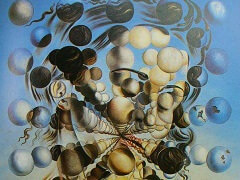Puzzle of Autumn, 1935 by Salvador Dali

In a series of still-life paintings executed roughly between 1934 and 1936, Dali explored the principle of figurative iteration as an extension of the paranoiac-critical method. Establishing thematic analogies through the repetition of morphologically similar objects, Dali opened the visual field to the play of multiple significations.
The title Puzzle of Autumn suggests a conundrum of sorts. On one level, it refers to the two jigsaw-like cutouts (an irregular object attached to the rear bumper of an antique car and its identical twin in the center of the composition from which a lion's head protrudes) that have been displaced from the rectangular box that rests on the foreground plane. On a deeper level, however, the title suggests the duplicity of vision and the treachery of the world of images through which the subject negotiates an uncertain path. Indeed, the form of the cutout reappears as an obsessive idea throughout the composition: in the ochre-colored "stain" among the clouds in the upper center of the composition, in the irregular formations of the rocks of Cap Creus in the middle ground, and, to the viewer's great surprise, in the contours of a group of bare-chested ballerinas to the left of the rectangular box. As with Dali's "anthropomorphic landscapes", the displacement of objects from their literal ground is transformed at the structural level through the device of formal repetition into an inversion of figure/ground relationships tout court. Violating the system of Renaissance perspective in which discrete objects in space are carefully demarcated, Dali envisions a new spatial regime in which figure collapses into ground and subject/object relations are radically decentered.























